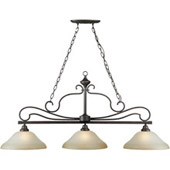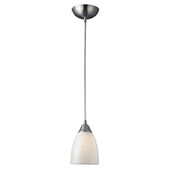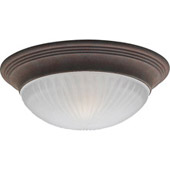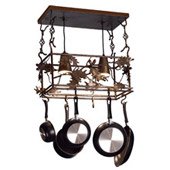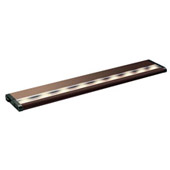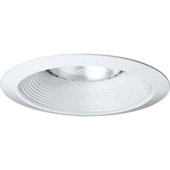
Kitchen Lighting
About Kitchen Lighting
Of all the rooms in a house, kitchens have the most requirements for light and present the most diverse opportunities for illumination. This is because of the different activities that take place in a kitchen. One activity, of course, is preparing food. Preparing vegetables? It starts at the sink where they are washed. Over-the-sink lighting can be a simple 24 inch fluorescent tube fixture with a diffuser, a flush mounted ceiling light, a recessed light, or a mini pendant.
From the sink we move on to a counter to chop the vegetables. This counter can be adjacent to the sink, underneath the cabinets. Since this usually is a dark space (light from the general fixtures in the middle of the ceiling doesn't reach this area very well), a perfect solution is under cabinet lighting. There is a variety to choose from, in lengths from 7 to 48 inches. These are modular--they plug into each other and can be controlled by one switch, so consistent brightness under all the cabinets can be produced by putting together several sizes of modules. Undercabinet lighting is available with different types of bulbs. Fluorescent can be cool-toned or warmer-looking. Incandescent will give a warm glow with a slightly yellowish tinge. Xenon bulbs are a whiter light, between cool fluorescent and incandescent, which would make food look very appealing by helping its true colors show. LED, the hottest trend in energy-efficient lighting, is another choice. Undercabinet lights come in different finishes, also. You can pick from wood grain, white, or brushed nickel to better coordinate with your kitchen's decor.
Another place to prepare vegetables can be on a kitchen island. Here illumination is provided by an island fixture, multiple hanging pendants, a pot rack outfitted with downlights, or simply recessed lights in the ceiling (these can be aimed to bring light right where you need it).
The food is prepared--now it is time to cook it. We move over to the stovetop and either downlights from a pot rack or vent hood will illuminate what's cooking in those pans. If there is no overhead vent hood, ceiling recessed lighting is a wonderful answer. Several recessed floods (incandescent, fluorescent, or LED) aimed at the burners will provide light needed to successfully follow that recipe!
The food is ready and it's time to eat. You sit down at the kitchen table over which hangs a lovely pendant, shining onto all the appetizing colors of the meal. Kitchen tables are a more casual environment than the dining room, so kitchen pendants can be simple or whimsical. After eating it is time to clean up. Recessed task lights or under cabinet lights shine on clean-up areas and the over-sink fixture illuminates the dishwashing process.
After dinner, it's time to relax in the adjoining living room. Later you might want a snack, so it is nice to have some dim lights on in the kitchen. The undercabinet lights, on a dimmer, glow just enough so you can walk into the kitchen, get your snack, and go back to your book or the TV in the living room, without having to turn on lights as you go. Dimmers create a mood with lighting and a kitchen is the perfect place to do it. A lighting control system consists of several dimmers that can be programmed to create certain scenes for specific purposes: a brightly lit one for cleaning, medium lighting for cooking, or soft dimmed lights for a romantic dinner atmosphere.

